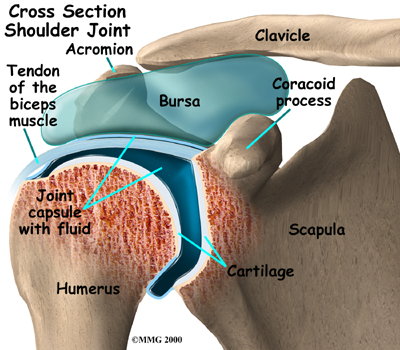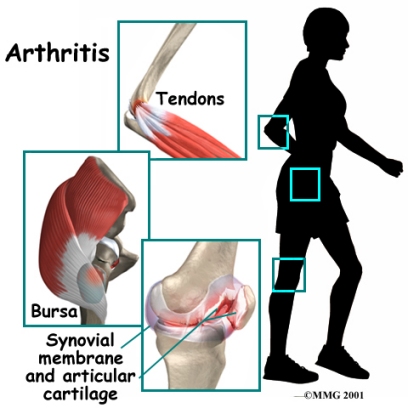Introduction
What is arthritis?
 Arthritis means inflammation of the joints. Inflammation generally includes symptoms of redness, heat, swelling, and pain. Many different diseases can result in inflammation of the joints. Arthritis is therefore a general term that describes more than one hundred different diseases of the joints of your body.
Arthritis means inflammation of the joints. Inflammation generally includes symptoms of redness, heat, swelling, and pain. Many different diseases can result in inflammation of the joints. Arthritis is therefore a general term that describes more than one hundred different diseases of the joints of your body.
In some types of arthritis, the cause of the disease is known, but in others it is still unknown. Some types of arthritis come on suddenly, and others develop slowly. Any joint can be affected, including the joints of your back, neck, knees, hips, shoulders, and fingers.
The diseases that cause arthritis can also attack muscle and connective tissue around joints. Some diseases may even damage other organs of the body, such as the kidneys, intestines, and heart. Due to the fact that the diseases inflame the joints, most arthritic conditions and related diseases involve chronic (long-term) pain. Over time, they may cause increasing damage to the joints or soft tissues of your body.
 Your joints are beautifully designed to minimize stress and damage while you move. Nearly all joints of the body are synovial joints. Most joints where two bones come together and must move against one another to allow motion are synovial joints. Smooth, slick articular cartilage covers the end of the bones so the bones themselves don't rub together. Synovial fluid lubricates the joint and allows easier motion as well as helps to provide nutrition to the cartilage of the joint. Around the joint, connective tissue forms a watertight sac that is called the joint capsule. Small, fluid-filled sacs, called bursae, cushion parts of the joint where friction is particularly high and could causing rubbing on bones, muscles, or other soft tissue. Ligaments connect the bones together and tendons connect the muscles to bones.
Your joints are beautifully designed to minimize stress and damage while you move. Nearly all joints of the body are synovial joints. Most joints where two bones come together and must move against one another to allow motion are synovial joints. Smooth, slick articular cartilage covers the end of the bones so the bones themselves don't rub together. Synovial fluid lubricates the joint and allows easier motion as well as helps to provide nutrition to the cartilage of the joint. Around the joint, connective tissue forms a watertight sac that is called the joint capsule. Small, fluid-filled sacs, called bursae, cushion parts of the joint where friction is particularly high and could causing rubbing on bones, muscles, or other soft tissue. Ligaments connect the bones together and tendons connect the muscles to bones.
A problem with any one of these parts of the joint can lead to abnormal biomechanics at the joint, resulting pain, and eventually inflammation of the joints, namely arthritis.

Many people of all ages suffer from arthritis. Almost two-thirds of arthritis patients are women, but for some specific types of arthritis the majority of sufferers are men.
Arthritis and related diseases are often painful to live with and sometimes very difficult to treat. The method of treatment will vary depending on the specific disease, however in nearly all cases, some form of drug management can be helpful. In addition, physiotherapy can be extremely useful to assist in pain management, as well as to ensure that changes in biomechanics due to pain or the breakdown of the joints from the inflammatory process itself is kept to an absolute minimum. Maintaining range of motion and strength of your joints and muscles is crucial to living with an arthritic condition.
Rehabilitation
Physiotherapy in Vaughan & Richmond Hill for Arthritis
At Rutherford Physio & Sports Clinic we can assist you in managing your arthritis. The exact treatment you require will depend on the specifics of your disease as well as your individual needs. Our aim is to assist you in managing your arthritis and helping you to be as active as possible.
When you visit Rutherford Physio & Sports Clinic your physiotherapist will begin by taking a complete history of your problem followed by a thorough examination of your affected joints. Your physiotherapist will ask you questions about where precisely your pain is, when the pain began, what you were doing when the pain started, and what movements aggravate or ease the pain. They will also want to know if you have had any investigations such as x-rays or other tests done, and if you have tried any other forms of treatment, such as medications, or simply even using ice or heat to decrease your discomfort.
Next your physiotherapist will do a physical examination of your affected joints. They will palpate, or touch, around your joints looking for signs and symptoms of arthritis, as mentioned above, such as swelling, redness, heat, or areas of tenderness. Depending on which joints are involved your physiotherapist may want to look at how you sit, stand, walk, or even how you squat, or jump. They will then take specific measurements of any joints that are affected to determine the range of motion in your joints. If possible, they will measure each range of motion so that they can determine if the range of motion improves or decreases over time; decreased range of motion is a tell-tale sign of a progression of arthritis.
Next, your physiotherapist will assess the stability of your joints to determine if there is any laxity of the ligaments or tissues of your joints. In some forms of arthritis this laxity can be a significant cause of the arthritis, and in other forms, the arthritic process itself causes the laxity. Too much laxity around the joints affects your alignment and the biomechanics of the joints, which can end up adding extra pressure onto an already irritated joint.
Your physiotherapist will also check the strength and lengths of the muscles surrounding your joints. Muscles, if weak or too tight, can contribute to the forces applied to a joint, which can lead to further pain and contribute to poor biomechanics.
Finally, your physiotherapist will assess how well you control your joints. The ability to know where your joints are in space without having to look at them is called proprioception. As a result of any injury, including an arthritic process, the receptors in your joints and ligaments that assist with balance and proprioception decline in their function. If your balance and proprioception has declined, your joints and your limb as a whole will not be as efficient in their functioning and this decline can contribute to further pain and progression of the injury.
Once your physiotherapist has taken a thorough history from you as well as completed a physical examination, they will determine the best treatment regime for your individual problem. As mentioned above, some forms of arthritis affect many joints and even some of your organs, whereas other forms may only affect one joint of your body, so your treatment plan will need to be specifically designed just for you.
Your physiotherapist will discuss with you how much activity or rest is advisable in your individual case; some forms of arthritis go through periods of flare-ups and at this time they require rest in order to be effectively managed. Other forms of arthritis do not respond well to limited activity, and actually improve if the joints are being kept mobile and the patient continues to be active. If you are already an active individual, your arthritis may threaten to slow you down, but your physiotherapist can discuss with you forms of cardiovascular activity that may be safe to continue even while you are experiencing discomfort. Often these activities involve non-weight bearing sports such as activities in the pool, or cycling.
Physiotherapy treatment at Rutherford Physio & Sports Clinic can also directly assist with any discomfort you feel in your joints due to the arthritis. You may yourself notice that your joints respond well to ice or heat, so this will be encouraged. Other modalities that we can offer, such as ultrasound or electrical modalities, may also assist with managing your pain. Your physiotherapist may even suggest alternative treatments such as acupuncture, which can also assist in managing the pain of arthritic joints.
The range of motion in your joints inevitably will decline due to the arthritic process if you do not actively maintain the motion of your joints. Your physiotherapist will prescribe specific stretching exercises for you that will combat this decline in range of motion. These stretches should be done as part of a home-program. Your physiotherapist may even help to maintain the range of motion while you are at the clinic by mobilizing the joints. This hands-on technique encourages the joints to move gradually into their normal range of motion.
Next your physiotherapist will prescribe the appropriate strengthening exercises to target any weak muscles that are affecting your biomechanics and alignment. These exercises will also be done as part of your home program. In addition, exercises that challenge your proprioception will also be prescribed. Improving your proprioception can ease the pressure on your joints and help to avoid any further injury.
Lastly, your physiotherapist will discuss the possibility of using braces or taping to ease your arthritic discomfort and to assist your biomechanics and alignment. Taping can often be used on a trial basis before an expensive brace is purchased, but because arthritis is long-term problem, a brace is usually purchased eventually if the tape has been helpful. There are numerous braces and supports that can assist with arthritic joints depending on your individual need, and your physiotherapist can discuss these with you. If required, they may refer you on to a specialist in bracing and supports, such as an Orthotist or an Occupational Therapist.
Most times arthritis, no matter which type, responds well to the treatment we provide at Rutherford Physio & Sports Clinic. There are times, however, that some forms of arthritis may not respond as well, or may plateau in their improvement with the treatment we provide at Rutherford Physio & Sports Clinic. If this is the case for you, your physiotherapist will liaise with your doctor regarding the appropriate ongoing management of your arthritis. Some cases may require referral to an Orthopaedic Surgeon to discuss the possibility of joint replacement surgery if the joint is too painful to manage conservatively, or if the alignment of the joint has progressed so far that it is not allowing the joint to function efficiently.
Portions of this document copyright MMG, LLC.
Rutherford Physio & Sports Clinic provides services for physiotherapy in Vaughan & Richmond Hill.